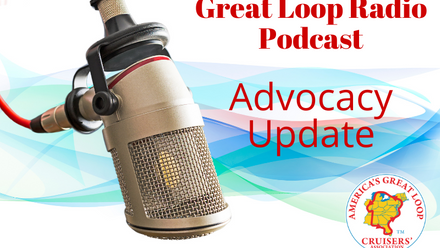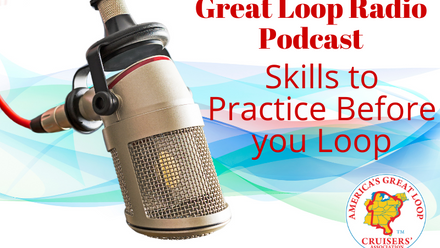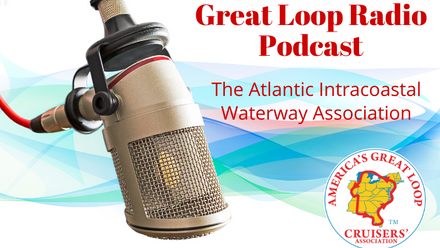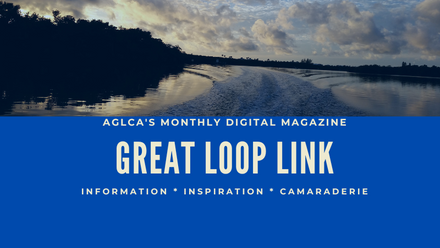AGLCA Advocates for Safe and Unfettered Access to the Great Loop Waterways

Please contribute to our annual advocacy fundraising campaign so we can continue our efforts.
As we reported in last month’s Great Loop Link and the AGLCA forum, the City of Miami Beach is working to eliminate overnight anchoring at the most popular anchorages in Biscayne Bay. Whether or not you’ve been following along, this article will bring you up to date on what’s happening with this bill, which is being considered at the Florida State House right now. New information is arriving at a rapid pace, so in addition to reviewing the details here, please look for updates via our forum. We may be posting calls to action if a grassroots effort is needed.
The Background
AGLCA has been working for years in Tallahassee to preserve your ability to anchor in Florida. In 2015 when cruisers were absent at the capitol, waterfront homeowners and their lobbyist were able to push through a bill that eliminated overnight anchoring in three of the Venetian Islands, which are part of the City of Miami Beach and are in Biscayne Bay. After losing those anchorages, AGLCA and other cruising associations became active, and in the nearly 10 years since then, we’ve fought successfully to ensure that the many bills filed to close more anchorages to overnight stays were defeated. In 2021, as both sides grew weary of the year-after-year fight, the stakeholders reached a compromise that received widespread support, passed in both houses of the legislature, and was signed into law by the Governor. The compromise created Anchoring Limitation Areas (ALAs) and a process by which counties can establish them. ALAs cannot be more than 100 acres in size, must be marked, and the aggregate total of ALAs in a specific county may not be more than 10% of the navigable waterways. A county must work through FWC and a public hearing process to establish an ALA. This was a win for cruisers because even where an ALA is established, vessels can remain at anchor for up to 45 days, which is more than enough for active cruisers like Loopers. For the cities and counties, ALAs were said to give more “teeth” to their legal authority to rid the waterways of derelict and long-term, stored vessels that hadn’t moved for more than 45 days. As part of that legislation, the three Venetian Islands that were already closed to overnight anchoring were grandfathered with that status, but the expectation was that new anchoring restrictions would come via the new ALA procedure.
This Year
Instead of following the process set forth to establish an ALA through the county and FWC, the City of Miami Beach chose to crack open the grandfathered part of the state code to attempt to close its shoreline, and 200 yards beyond it, to overnight anchoring. While places like Jacksonville, Hollywood and Pinellas County are using the ALA as expected, Miami Beach decided to bypass that process in favor of a complete closure.
When working on these types of issues, we often start by trying to understand the reason for the bill or the problem the bill is intended to solve. Of note, in this case, the reason for the bill keeps changing. When they argued that boaters were discharging waste and polluting the Bay, we countered that such actions are already illegal and ending the problem would require more enforcement, not more laws. When they argued that the boats anchored are abandoned and/or derelict, we pointed out that we, too, would like to clear the waterway of those vessels and that the 45-day anchoring limitation areas were introduced in 2021 to solve exactly that problem. We suggested that going from the 45 days allowed in the ALA statute to zero days at anchor was arbitrary, they wouldn’t budge from their position and when asked what an appropriate number was, they had no answer. It appears that the real problem is waterfront homeowners who simply don’t want to see boats outside their windows.
We, too, are against pumping blackwater overboard, abandoning a boat and other bad behavior on the waterway. But our arguments that more enforcement is needed, rather than more restrictions, have fallen on deaf ears as the bills sailed through two House committee hearings and one Senate committee hearing to date.
Following the Senate committee hearing on January 23rd, we started to see some signs of progress for our side. During the hearing, Senator Mayfield requested that boaters meet with the bill’s sponsor to find a solution that works for everyone. Since then, our lobbyist and our coalition of recreational boating associations, which includes AGLCA, DeFever Cruisers, Marine Trawler Owners Association (MTOA), and Seven Seas Cruising Association (SSCA) have been working to find a way to keep these areas open for boaters that will satisfy the City of Miami Beach.
Sadly, without our lobbyist, we do not even have a seat at the table, which is why it is so important for members to contribute to paying that bill.
Make no mistake. If Miami Beach is successful in adding the areas within 200 yards of their shoreline to the places where overnight anchoring is prohibited, there will be a slew of additional municipalities doing the same next session.
How Much Do We Need to Raise?
This year’s fundraising goal for AGLCA’s advocacy efforts is $24,000. Nearly all of that will go to pay our lobbyist in Florida. In other states, AGLCA’s Home Port Crew and grassroots efforts have been enough to make progress. But Florida accounts for more miles of the Great Loop than any other state, and it tends to be a bellwether state when it comes to boating laws. We share the cost of our Florida lobbyist with our coalition partners and these groups divide the lobbyist’s costs based on the number of active memberships for each. With AGLCA accounting for well more than half of the total membership of these organizations, our share of the lobbyist’s contract in 2024 is $22,395.
To date we have collected $5,467 towards this year’s goal. This is in large part due to early and generous contributions from some of the boats that participated in our Flotillas when the Illinois Waterway reopened in October. They chose to contribute to the advocacy fund as a “thank you” to the Home Port Crew for our work on that project. We are so grateful for the head start on this year’s goal and we hope more of you will follow that lead.
Who Should Contribute:
We do not just advocate for you in Florida. AGLCA is active in many states, and we track issues in all states along the Great Loop route. Please contribute if you want:
- Continued access to anchorages when you cruise the Great Loop
- Continued access to anchorages in your home waters
- The Great Loop waterways to remain open to navigation
- The Great Loop waterways to remain safe for cruisers in future years
Some of the Issues We’ve Successfully Tackled in the Past
This is not just a Florida issue. Here are some of the other states in which our advocacy efforts have already made a difference:
New York: There were efforts in the State of New York to change how the Erie Canal is managed via a short-cut, 30-day budget amendment that precluded public input and the usual debate cycle a bill would normally receive. Loopers stepped up and made our voices heard! Both the New York State Assembly and Senate did not move the Erie Canal Revitalization Act forward as part of the budgeting process.
Georgia: A bill that required a permit to anchor for even one night anywhere in the State of Georgia passed the legislature and was signed into law before the industry took notice. AGLCA and others worked to get the law changed the next session and were successful in advocating for a new law that allows you to anchor anywhere in Georgia for up to 14 days. Stays at a single anchorage for greater than 14 days requires a long-term anchoring permit, but most Loopers don’t spend two weeks in Georgia, let alone at anchor in one place.
South Carolina: A bill was proposed that would allow local jurisdictions to require a permit to anchor in their waters for more than 14 days. AGLCA contacted South Carolina legislators and provided information on what this bill would mean to transient boaters and how other states like Georgia and Florida have dealt with this issue in more effective manners. Kim Russo from AGLCA’s Home Port Crew attended subcommittee hearings to provide testimony on the proposed law’s impact on boaters. Specifically, she endorsed 14 days at anchor in one place is enough time, but emphasized that it may not be long enough in an entire jurisdiction. The result was an amendment, and subsequent passing of a new South Carolina law, that limits anchoring to 14 days within a five-mile radius which allows active cruisers to remain in an area for an extended amount of time as long as they move five miles every two weeks. This also means that a local law in Folly Beach, South Carolina, where anchoring was prohibited within one mile of public boat ramps, is superseded by the state law.
We are actively monitoring legislation in all states along the Great Loop route so that we can work to ensure the route remains safe and navigable for Loopers. We are watching many bills related to ridding the waterways of derelict and abandoned vessels, which we support. We are also closely monitoring a bill in South Carolina that would require marine recovery insurance for any boat anchoring in the State’s waterways for more than 14 days. This has been suggested in many areas as another possible solution to the derelict vessel issue so it will be interesting to see whether it passes and how it is implemented.
In recent years, proposals to close specific locks to control the migration of invasive species have emerged which could close off some of the Great Loop or its side trips. Further, the long-term viability of the Erie Canal and other New York State Canals have been questioned because the cost to maintain them for through navigation is significant. These are the types of issues that are threats to the Great Loop, and they are part of AGLCA’s advocacy efforts on behalf of our members. But we cannot continue without member support. We do not fund these efforts from general membership dues because we know not all members agree on the issues.
Please contribute today. We appreciate your support!






